
Rain, rain, and more rain.
I hike uphill on the muddy trail. Around me the forest is hushed. Even birds have sought shelter from these storms.
I enjoy the silent pause between showers. My footsteps squish on the spongy ground.
I round a bend in the trail to encounter an unexpected obstacle. A magnificent Douglas Fir has fallen across the trail. The jumble of green branches creates an impenetrable wall across my path.
Water drips from the hood of my rain jacket. I feel a chill creeping into my bones. And as I ponder a way around the obstacle, I think “A hot drink would be lovely.”
Moving carefully, I draw my bushcraft knife and cut a handful of branches from the “top” of the tree. And I give silent thanks to the Douglas Fir for providing its needles.
I regard the fallen giant a moment longer, then continue my climb to the trailhead.
This article contains affiliate links…
The Amazing Douglas Fir
The Douglas Fir (Pseudotsuga menziesii), is an evergreen conifer in the pine family. Trees grow between 70 – 300 feet tall, depending on growing conditions. They abound in the coastal forests of northern California where I live. And it’s easy to overlook these amazing trees.
The tree is named for Scottish botanist David Douglas (1799-1834). Douglas traveled the Pacific Northwest and introduced more than two hundred of its plants to Great Britain. His name is attached to more than eighty species of plants and animals.
It’s worth noting that the Douglas Fir is not really a fir at all. Fir trees are in the Abies genus. While Douglass Fir is Pseudotsuga (false hemlock).
Douglass Fir Tea
Douglas Fir needles are high in vitamin C, vitamin A, and antioxidants. I’ve been told that a cup of tea made from its needles has more vitamin C than an orange. Several Native American groups in California drank tea made from its needles.
If you nibble on Douglas Fir needles, you experience a burst of tangy citrus (from the vitamin C), followed by a “pine-like” flavor. I love this taste! And I relish tea made from Douglas Fir needles more than from any other tree.
How to Make Douglas Fir Tea
Here is how I make Douglass Fir tea:
Step 1: Harvest
Identifying Douglas Fir trees is beyond the scope of this article. I look for the X-shape or spiral shape the needles make when I view a branch end-on. I also examine the bark and the fallen cones surrounding the base of the tree.

The new growing tips are the most nutritious. They are best in Spring, and may be found from March until June. The growing tips appear lime green compared to the mature needles.
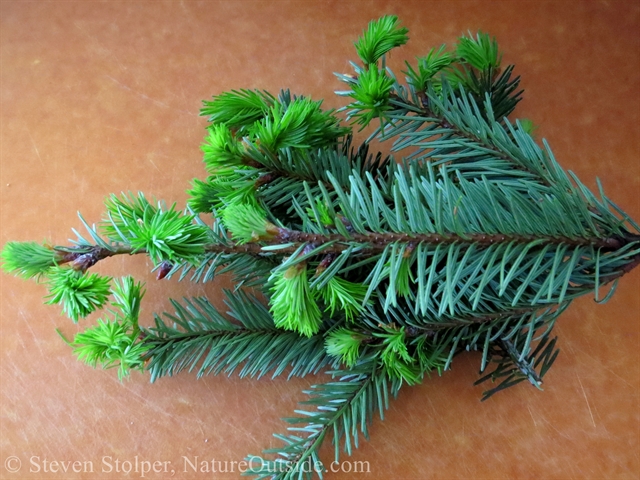
The growing tips appear lime green compared to older, mature needles.
You can use the mature needles to make tea. But be sure to trim the needles from the brownish-orange stems that can be bitter and taste like resin.
Step 2: Equipment
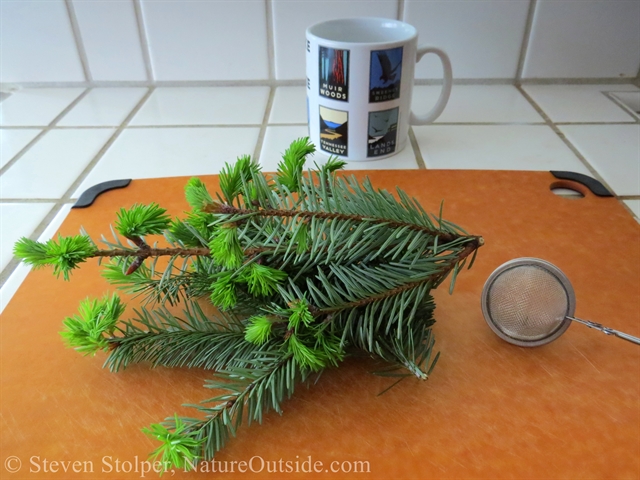
The only thing you really need is Douglas Fir needles and a cup. The infuser is optional.
You don’t need special equipment. I happened to have my bushcraft knife handy, but you can use a kitchen knife to prepare the needles. Grab your favorite mug and a tea infuser if you have one (not required).
Step 3: Cut the Needles from the branches
Cut the growing tips from the branch with your knife. You can cut at the junction where the cluster of growing needles attaches to the stem.
If you are using mature needles, pluck or cut the needles off the branch individually so that you do not have any stem in your pile of needles.
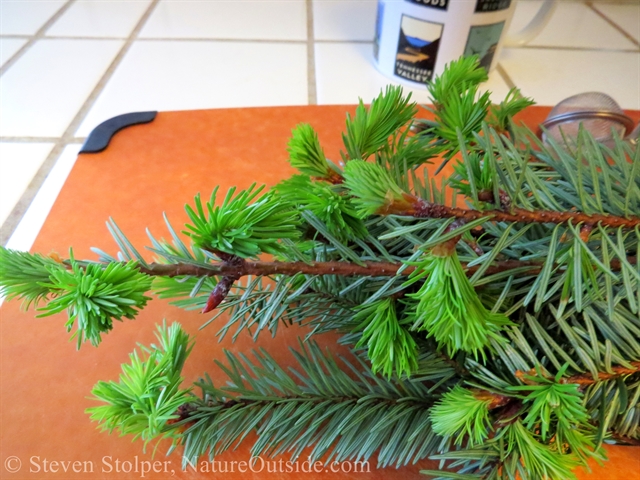
Separate the tufts of bright green needles from the branch
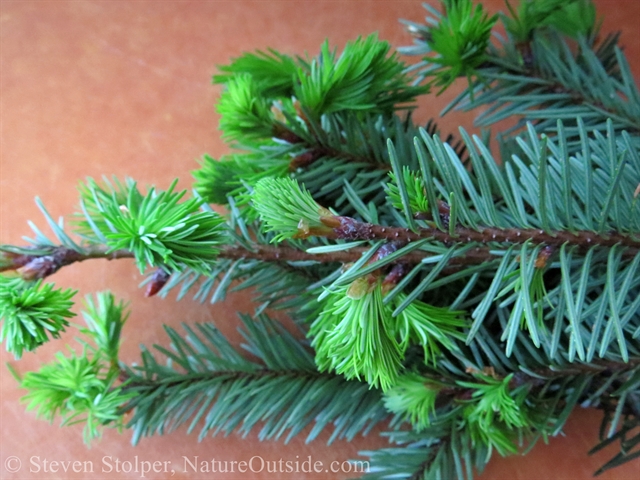
A closer look at this year’s Spring growth.
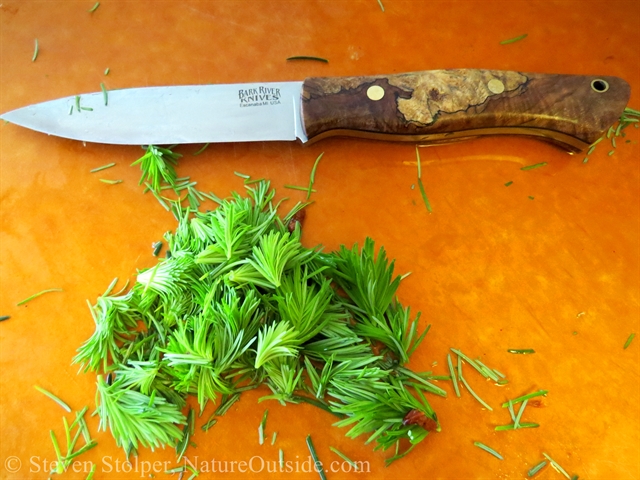
The fresh tips trimmed from the branch
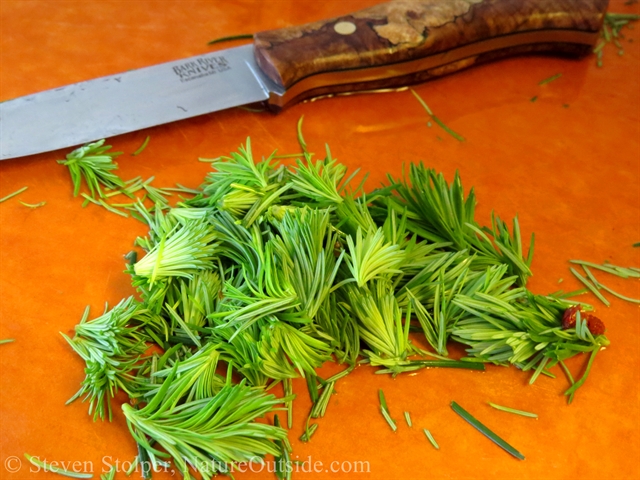
A handful of needles will do quite nicely.
Step 4: Chop the Needles
Chop the needles with your knife using a gentle rocking motion. Chopping the needles allows greater access for the hot water to dissolve the nutrients from the needles.
Step 5: Place Needles in infuser
If you have an infuser, load the chopped needles into it. Otherwise, scoop the needles into the bottom of your mug.
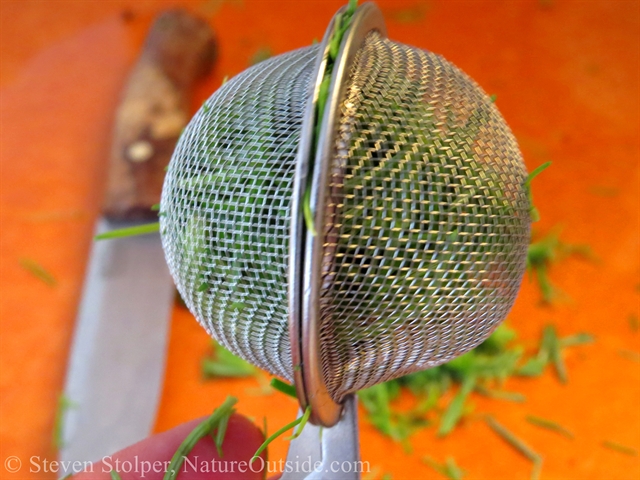
Douglas Fir needles in an infuser
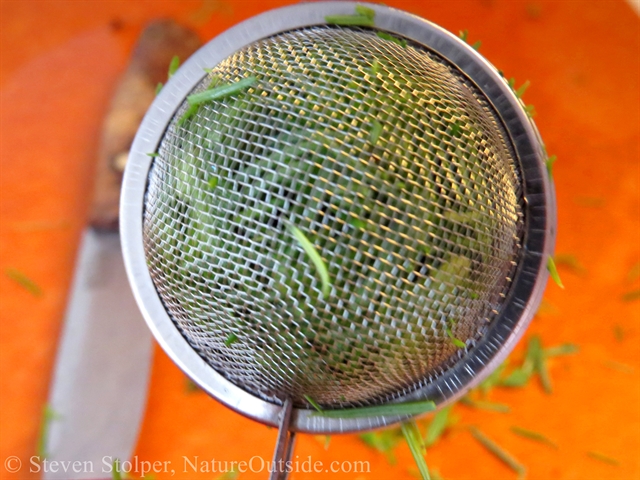
Douglas Fir needles in infuser
Step 6: Pour hot water and Steep
Boil water, and remove it from the flame so the boiling stops. Then pour it over your needles into the mug.
I’ve heard two stories regarding boiling water for herbal teas. The first is that you retain more vitamins by letting the water stop boiling before pouring it over the needles. The second is that the vitamin C is unaffected by the boiling water.
I choose to let the water stop boiling before I pour it over the needles.
Steep the needles for five minutes (10 minutes if you don’t plan to sweeten it).
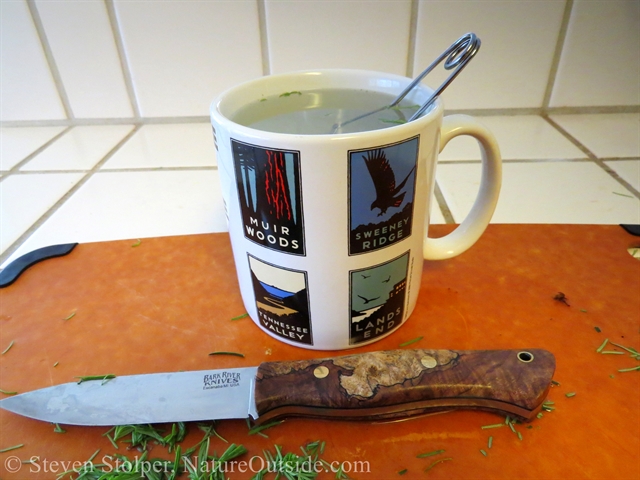
Steep the tea for five minutes (10 if you do not plan to sweeten it)
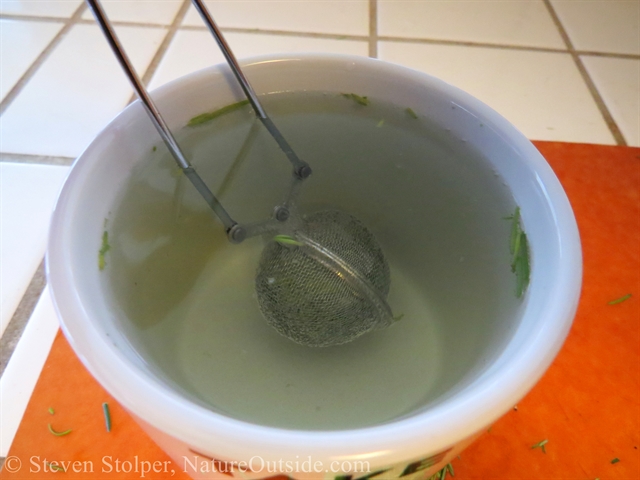
Douglas Fir tea after five minutes of steeping.
Step 7: Add honey (optional)
You can add a sweetener if you like. I use a small amount local honey.
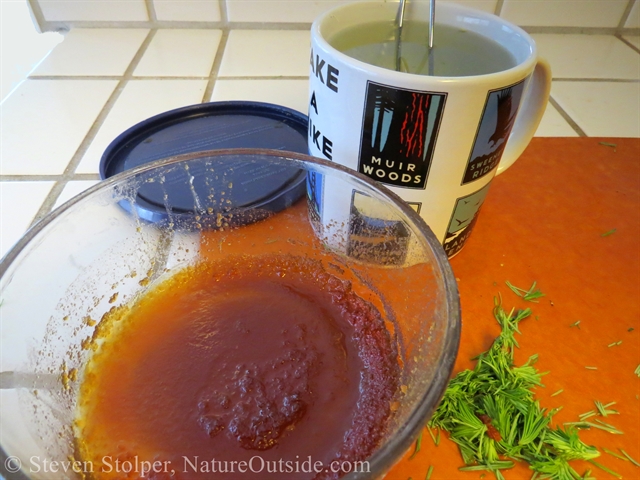
I occasionally add local honey to the brew
Steep 8: Continue to Steep
Allow the honey to dissolve and steep the tea for an additional five minutes. The total brewing time for the tea should be between five to ten minutes (according to your taste).
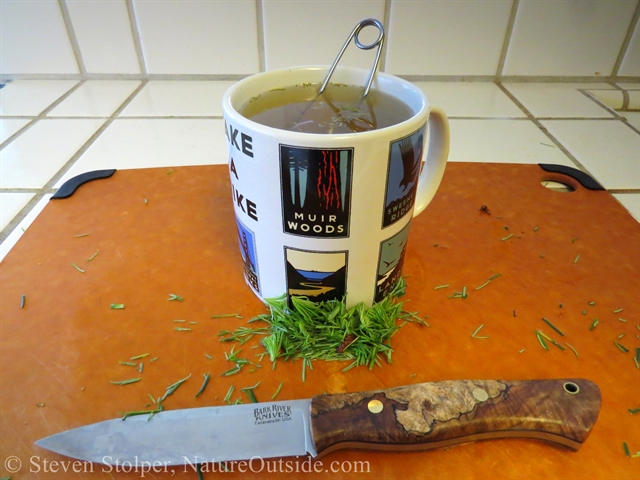
Continue steeping the tea.
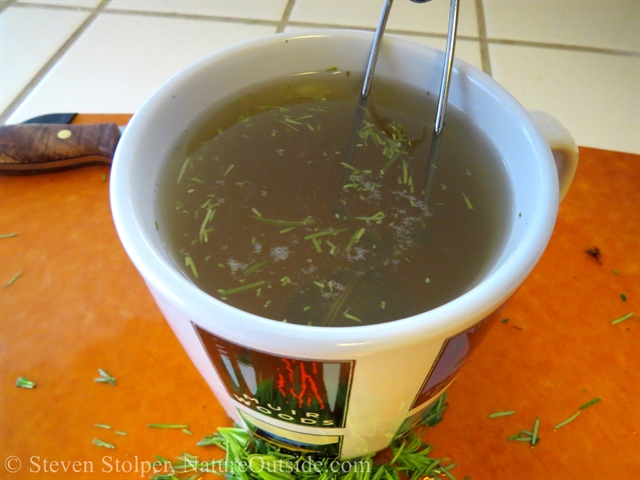
Douglas Fir tea after 10 minutes of steeping (and honey).
Step 9: Enjoy!
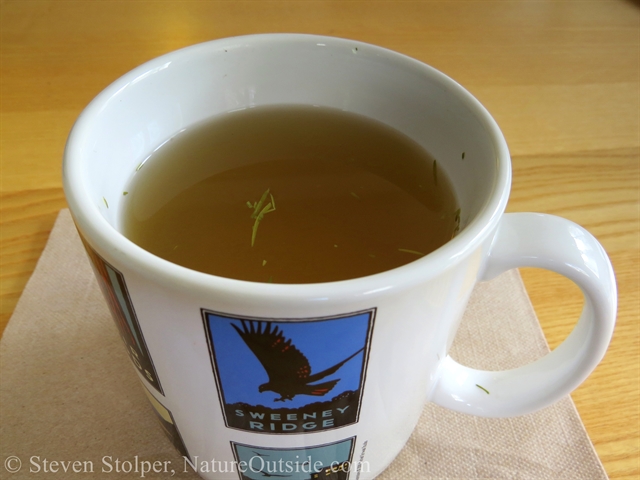
Yummy Douglas Fir tea.
I’ve enjoyed Douglas Fir tea around the campfire, and at home after dinner. I’ve also sipped it after a breakfast of Cattail pancakes. However you choose to enjoy it, you will love Douglas Fir tea!
Caution about Making Tea from Conifers
It’s important to identify the tree correctly, which is beyond the scope of this article. Needles from some trees are not safe to eat – and are actually toxic! Learn about the conifers in your area and how to identify them.
Avoid the tea if you are pregnant or trying to become pregnant. I have heard this warning from time to time, but I have been unable to discover medical reasons behind it. But I’m passing it along so you can exercise good judgment.
Make Douglas Fir Tea for Yourself
Drinking Douglas Fir tea joins us in kinship with our ancestors. It Blurs the line between food and medicine, and allows us to enjoy the restorative power of nature. Experience nature on your next hike through this wonderful warming drink.
References
- California Foraging: 120 Wild and Flavorful Edibles from Evergreen Huckleberries to Wild Ginger (Regional Foraging Series)
- Edible and Useful Plants of California (California Natural History Guides)
Related Articles on NatureOutside
Bushcraft Dessert – Make a Lavender Dip for Strawberries
For fun facts and useful tips, join the free Bushcraft Newsletter.



Thank you for this! Really vital medicine in the time of Covid19. Also, I think super high amounts of vitamin c are recommended to avoid for pregnancy because it could lead to miscarriage early on.
Thanks
I’m glad you enjoyed the article, Melanie.
There is no credible scientific information suggesting that the recommended amount of vitamin C has a negative effect on pregnancy, implantation, or menstruation. But as you point out, it is a good idea to avoid taking mega-doses of any vitamin. And that includes vitamin C. Douglas Fir tea has significantly more vitamin C than oranges. So women should consult their physicians to determine how much is safe to ingest during pregnancy.
The reason they say to avoid pine needle tea when you are pregnant is because some pines have been known to cause miscarriage in cattle when they drink from puddles under the trees or when they eat the needles. Lodge Pole pine is one of these.
Thank you for your comment, Christine! You are absolutely right. The reason people advise against consuming pine needle tea when pregnant is because of its observed effect on cattle.
Can young children drink pine needle tea? Can women who breastfeed consume it, as long as it is a non-toxic pine?
Jennifer, I did some research and was unable to find authoritative information. As you know, word of mouth is not to drink pine needle if you are pregnant. I have also found one website that sells tea recommend that breastfeeding mothers not consume pine needle tea. They suggest that it reduces lactation. I was unable to find anything about children and pine needle tea.
In the absence of good medical information, I would not consume pine needle tea if you are pregnant or nursing. But I would feel comfortable giving children a few sips. I would not allow children to consume large amounts of the tea. And for children, a “large amount” is much smaller than for an adult.
I’ve been making this tea and mixing it with my homemade kombucha. So refreshing and good for you.
Melissa, that sounds great!